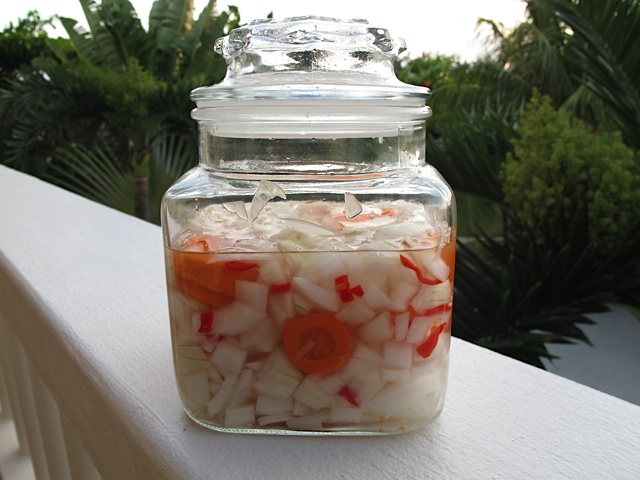Click here to view recipe.
I have to laugh whenever I look at the title of this post… “The Condiment” is the name we bestowed on the concoction Wayne threw together before my arrival at our home in Belize earlier this month. We don’t always travel together – he often gets to our Belize house a few days earlier or leaves a few days after I depart. We are fortunate to have this flexibility; we both have such busy lives and we travel so frequently that it’s nice to come and go on our own schedules. There is one rule however: he (or she) who arrives first must grocery shop and cook, and she (or he) who leaves last must go through our check list and clean up. So when I walked in a week after my husband arrived, the fridge was full of all sorts of grocery items including stewed black and red beans, “the condiment” and my favorite roast chicken. Dinner was ready. I cannot tell you how happy this made me after my 3am wake-up call and nine hour flight! And “the condiment” was something neither of us had ever made…
This “condiment” is available all over San Pedro. We find jars of bright vegetables swimming in vinegar on the tables of almost every take-away restaurant and even at the fancy places. There doesn’t seem to be a precise recipe, per se – so Wayne analyzed the containers in town and struck out on an expedition to collect all the ingredients.
This recipe is truly his own. I have never had sliced carrots in “the condiment” but I love the texture they provide. We’re both careful when handling habaneros, wearing gloves so the oils don’t stay on our hands for the rest of the day. Wayne added the habanero seeds which makes this fiery hot, so if you want a milder mix add only the habanero flesh and discard the seeds. During his mission to replicate “the condiment,” Wayne learned that the red habaneros are hotter than the orange, yellow or green varieties here. Also, many locals told him to only use white onion (they said the brown skinned or red skinned onions don’t stay firm). But this is a small town in Belize and there were no white onions to be had so he made due with the brown skinned variety. They work just fine but the locals were right – the second batch we made with white onions stays a little prettier.
I love to eat heaps of this alongside tacos, grilled fish or chicken. We even have it with our morning eggs! Because of the texture, I even prefer it to my beloved hot sauce.
“The Condiment”
Ingredients
- 2 white skinned onions, roughly chopped into ½ inch pieces
- 3 medium sized carrots, peeled and thinly sliced
- 1 Tbsp sea salt
- 2 sliced red habaneros, seeds and all
- 1 Tbsp raw (turbinado) sugar
- Plain white vinegar*- enough to barely cover the vegetables in the quart glass jar.
*It’s funny… I add the sugar only because the first time he made it, Wayne used “Mexican” vinegar, and when we looked at the bottle it turned out it had sugar and “other flavorings” added–yet it wasn’t as mild as seasoned rice vinegar, for example. Since none of the Belizeans use anything besides plain vinegar, that is what I did for the second batch but I needed the sugar to tone it down a bit.
Instructions
Place everything but vinegar and sugar into a glass quart container and mix. Pour plain white vinegar with sugar stirred in (it won’t dissolve but don’t worry) to barely cover the vegetables.. Stir every 30 minutes for the first hour-and you can actually eat it after this. This keeps for up to a week in the refrigerator.
So easy, you have to make “the condiment” sometime this summer people!
PS: My favorite snack or lunch down here is to take a mound of warm cooked quinoa, cover it with warm stewed beans. I then spoon about 2 Tbsp of “The Condiment” on top and I’m good to go. Another good reason to make and serve this in hot weather: it creates big time THIRST and you have no choice but to drink oodles and gobs of water; therefore you stay hydrated when the temperatures hit the high numbers.







